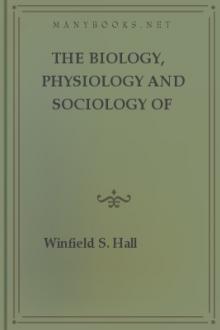The Biology, Physiology and Sociology of Reproduction, Winfield Scott Hall [latest ebook reader txt] 📗

- Author: Winfield Scott Hall
- Performer: -
Book online «The Biology, Physiology and Sociology of Reproduction, Winfield Scott Hall [latest ebook reader txt] 📗». Author Winfield Scott Hall
The prostate gland, a portion of which is homologous with the female uterus and called uterus masculinus, is situated around the neck of the bladder and is traversed not only by the urethra (prostatic portion), but also by the ejaculatory ducts. There are numerous gland ducts which—collecting the secretion of the prostate gland—open into the urethra in the prostatic portion.
Just beyond the prostate are two small glands called Cowper's Glands whose ducts enter the urethra some distance beyond the prostate, at the root of the penis.
In the treatment of the physiology of the various structures just described, we may well reverse the order of treatment, thus leading up step by step to a consideration of the more important organs.
a. Urethra. The canal or duct of the penis is called the urethra, and it is important in considering its physiology to remember that it has not only a double function to perform, but that the performance of one function in a measure temporarily unfits it for performance of the other and makes it necessary for a special measure of preparation.
The urinary excretion from the kidneys collecting in the urinary bladder is passed out periodically through the urethra. This same channel must transmit periodically secretions from the sexual apparatus.
b. Cowper's Glands secrete only under sexual excitement, and usually they secrete only when the sexual excitement reaches a stage which induces an erection. The secretion is composed of a clear alkaline mucus.
The purpose served in the natural economy by this alkaline mucus is a very important one and it is essential that every young man should understand it.
It will be remembered that the male urethra affords passage not only for the urine, but also for the generative products. The urine is acid in reaction and the frequent passage of urine along the urethra leaves that duct acid in reaction under usual conditions. The spermatozoa are very sensitive to acid and their vitality is seriously impaired by acid of any kind, particularly the acid of the urine. Nature has provided that the secretion from Cowper's glands should precede the generative products along the urethra, thus neutralizing the acid and insuring for the spermatozoa an alkaline passage from the body.
Besides this important function of the secretion from Cowper's glands, the slimy transparent mucus appearing at the glans penis under sexual excitement serves as a natural lubricant covering the glans of the male organ. A secretion from the female similarly prepares her organs for sexual contact so that the delicate mucous membrane, particularly of the female organs, shall not suffer abrasion.
Many young men have experienced the appearance of the secretion from Cowper's glands and wholly misunderstanding its nature have feared that they were losing some vital fluid. This misunderstanding of the nature of this fluid makes the young man especially subject to the misrepresentations of the advertising quack and charlatan who allege that he is losing vital fluid and will, if not treated, undergo general debility and loss of procreative power. This brief explanation of the significance of the secretion of Cowper's glands will protect the young man from any such misrepresentations.
c. The Prostate Gland.—That the prostate gland is intimately associated with reproduction is evident from the fact that in those male animals that have suffered castration before puberty, the prostate gland withers and practically disappears. What then is the role that this gland plays? Like Cowper's glands, it secretes only during sexual excitement. Under such excitement its ducts become gorged with a secretion peculiar to it and at the moment of the emission or the ejaculation of the semen the numerous ducts empty their contents into the urethra to be mingled with and made a part of the semen.
The secretion of the prostate is composed of a watery solution of protein and of alkaline salts and so closely similar to the secretion of the seminal vesicles that we will consider its action along with that of the secretion from the vesicles.
d. The Seminal Vesicles.—The seminal vesicles secrete continuously. The secretion is composed of an aqueous solution of albumin and of alkaline salts. This secretion together with the secretion from the prostate gland is poured into the urethra at the moment of sexual orgasm; they become mixed in their transit through the urethra with the secretion from the testes. This mixture is known as semen. [See pg. 42.]
It used to be supposed that the semen was secreted wholly by the testes; that the testes were secreting continuously and that the seminal vesicles were receptacles for the gradually accumulating semen from the testes. The researches of Steinach and others have made the old theory untenable and demonstrate that the semen is a mixture from three distinct sources; that the testicles secrete their contribution to the semen only during sexual stimulation; while the seminal vesicles secreting their products continuously become periodically filled and distended.
Let us inquire regarding the function of this alkaline albuminous secretion from the vesicles and prostate. For what purpose does Nature prepare such a secretion? The spermatozoa frequently remain several days in the organs of the female before the ovum is found and fertilized. During these several days the spermatozoa are exerting no small amount of energy in their vigorous flagellate movement. For such an expenditure of energy they must receive nourishment and stimulation. The nourishment is supplied by the albumin and proteid of the vesicular and prostatic secretions. The stimulation is supplied by the salts also secreted by these glands. The recent researches of Loeb and others have demonstrated the importance of mineral salts in stimulating the activity of living cells. One can cite no better example of this stimulant action than the influence of these vesicular and prostatic salts upon the activity of the spermatozoa.
The vesicles and prostate may be looked upon as the commissariat of the army of spermatozoa; the vesicles accumulating a stock of supplies to be drawn upon at short notice; the prostate representing a factory where a considerable quantity of supplies can be prepared at short notice.
This periodic distention of the seminal vesicles is a matter of very considerable hygienic importance and must be thoroughly understood by every young man who would lead a normal sexual life.
These organs in common with all other organs of the body are supplied with two sets of nerves, one set passing away to the spinal cord and carrying messages which indicate the condition of the organ or the presence and character of any local stimulus; the other passing away from the spinal cord to the organ and carrying secretory and motor impulses. The secretory impulses are more or less continuous and as a result, these glands secret continuously and become periodically distended as described above. The motor impulses pass to the muscles within the walls of the vesicles, causing a strong spasmodic contraction of these muscles at the moment of emission of semen, thus throwing the contents of the vesicles into the urethra at the same moment when the epididymis the vas deferens and the ducts of the prostate are emptying their secreted contents into the urethra.
Now the sensory nerves passing from the seminal vesicles up to the erection and emission centers are stimulated by any unusual pressure within the vesicles. Unusual pressure may be caused either by distention due to accumulated secretion or by pressure upon the vesicles from over-distended rectum or bladder. It sometimes happens that two or more of these influences are acting at the same time. These impulses are most likely to be effective when the subject is asleep, and particularly if he is lying upon his back. The result of the stimulus is to cause an erection, accompanied usually by an erotic dream, the whole phenomenon culminating in an emission of the contents of the seminal vesicles and followed, of course, by a relief of the pressure which was the cause of the condition. This phenomenon has been variously called nocturnal emission, "pollution" and "dreaming-off."
Vecki, a specialist in physiology, hygiene and pathology of the sexual apparatus, says that the nocturnal emission is a normal physiological phenomenon, the object of which is to relieve pressure in the seminal vesicles, and that in normal cases it occurs in fairly regular periods, these periods varying in length with different individuals, according to their physical condition and habits, the period being two to four weeks, usually; though a considerably longer or shorter period would not be looked upon as pathological. Vecki describes the normal nocturnal emission as being accompanied by an erection, erotic dreams, and an orgasm, the subject being wholly unconscious of the condition until he is awakened at the moment of orgasm. Normally, the subject experiences on the following day a feeling of relief and well-being and should, normally, be wholly free from headache, depression or languor.
Inquiry among a large number of normal healthy men convinces the author that it is not at all unusual for these emissions to occur as infrequently as once in two months in normal healthy men. On the other hand, it is not unusual for them to occur as frequently as once in ten days or even once a week and still be within the physiological limit. However, when the emission occurs as frequently as once per week, it should be looked upon as abnormal if it is followed by depression, headache or lassitude. Cases are not unusual in which the nocturnal emission is experienced as often as three times in a week after which there will be a period of two to four weeks without an emission, followed again by very frequent emissions, and a free period. This phenomenon is an individual peculiarity, and is not to be looked upon as abnormal.
Cases of too frequent nocturnal emissions accompanied by languor and headache are usually caused by irritability or lack of tonicity of the sexual apparatus, particularly of the seminal vesicles and the ducts. This irritability and loss of tone is not infrequently caused by masturbation, though it may also be caused by excessive sexual intercourse, making itself manifest, of course, in either case, on cessation of the habit of masturbation or the excessive sexual intercourse.
Another cause of too frequent nocturnal emissions and one wholly separate from any abuse of the sexual function is irritability and mechanical irritation of the sexual apparatus—perhaps especially the membranous and prostatic portion of the urethra—caused by the presence of an excessive amount of oxalates in the urine. Oxalates occur in the urine in sharp angular crystals and would seem to be in a high degree irritating to the tender mucous membrane of the upper part of the urethra. The almost invariable presence of these crystals in excess in those cases that have not been accounted for by abuse of the sexual function leads one to adopt the plausible theory that the crystals are the cause of the irritability. However, we must not lose sight of the fact that these crystals may be simply an accompaniment of the too frequent emissions, and that the presence of oxalates in the urine may be caused by some disturbance in the nutritive processes that go on in the body, which disturbance causes not only the irritability of the sexual apparatus, but also the presence of the crystals.
When the seminal vesicles are much distended it occurs not infrequently that the passage of a hard mass of fecal material through the rectum will, by simple mechanical pressure on the seminal vesicles, force out





Comments (0)